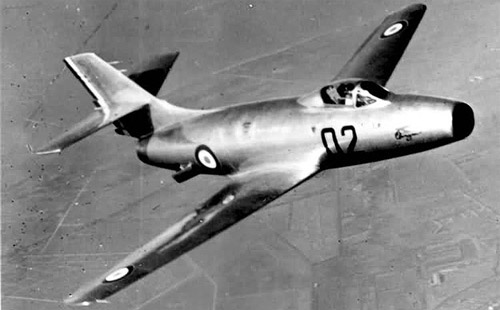MD-450 Ouragan
Summary
| Category | Combat Aircraft |
| Origin country | 🇫🇷 France |
| Manufacturer | Dassault |
| First flight | 28 February 1949 |
| Year introduced | 1952 |
| Number produced | 567 units |
| Average unit price | $1 million |
Description
The Dassault M.D.450 Ouragan was conceived following World War II, driven by Marcel Bloch's vision to revitalize the French aviation industry with an all-French jet-powered fighter. In early 1946, Bloch renamed himself and his company Dassault. In 1947, despite lacking firm government backing, Dassault initiated the M.D.450 project as a private venture. The design, influenced by American aircraft, emphasized a rapid rate of climb for its interceptor role and utilized a Rolls-Royce Nene turbojet engine, license-produced by Hispano-Suiza. In December 1947, detailed design work began, leading to the construction of three prototypes, with the first, M.D.450-01, making its maiden flight on 28 February 1948. This initial prototype lacked pressurization, armament, and wingtip fuel tanks. Following positive government response to the project, contract No. 2223/48 ordered the construction of three prototypes. Production was ordered in August 1950, but Dassault's production capacity was insufficient to meet demand, and portions of the work were subcontracted to other manufacturers. On 5 December 1951, the first production Ouragan conducted its maiden flight.
The Dassault Ouragan was an early jet-powered fighter aircraft employing a straightforward layout, featuring a single divided air intake in the nose feeding air around the cockpit to the engine directly behind the pilot. It had a cylindrical fuselage tapered at both ends, a nose intake, a bubble canopy, and tricycle landing gear. The design incorporated relatively thin wings and a swept-back vertical stabilizer. Power came from a single Rolls-Royce Nene turbojet engine, license-produced by Hispano-Suiza. Early models used Martin-Baker Mk.1 ejection seats, but most production aircraft had SNCASO E.86 ejection seats. Aerodynamic features included a swept tailplane and a thin, tapered wing. The aircraft was reported to be highly stable while firing but prone to flat spins during tight turns due to its relatively low length-to-diameter fuselage ratio. Export variants like the Barougan had brake parachutes and a two-wheel main gear configuration for rough field operations.
The Ouragan's typical weapons stores reflected an attack role. It could carry two 450 kilogram (1000 lbs) bombs, 16 105-millimeter (4 inch) Matra T-10 rockets, or eight rockets and two 460 liter (121 US Gallon) napalm bombs. The maximum payload that could be carried on four external hardpoints was 908 kg (2,002 lb), which could include various unguided iron bombs such as two 227 kg (500 lb) bombs. Alternatively, drop tanks could be carried for extended range. In addition to external payload, the aircraft were armed with four Mark V 20mm Hispano cannons beneath the engine intake. Some preproduction models were fitted with two 30 mm (1.181 in) DEFA cannon.
In August 1950, prior to the delivery of any pre-production aircraft, the French government ordered 150 production Ouragans, with ambitions to eventually operate as many as 850 with the Armee de l'Air. The Ouragan formally entered squadron service with the French Air Force in 1952, replacing aircraft like the de Havilland Vampire. Its frontline service was superseded by the Dassault Mystère IV from May 1955. In 1961, the last Ouragans were displaced from operational units, though some were retained in secondary roles such as advanced tactical and gunnery trainers until the mid-1960s. India also operated the Ouragan, locally named Toofani, from 1953, using it in airstrikes against Portuguese forces in Diu in 1961 and in ground-attack missions during the 1965 conflict. In 1965, one strayed over the border with Pakistan and was captured. Israel acquired at least 75 aircraft by 1955. Israeli Ouragans flew ground-attack missions and escort during the 1956 Suez Crisis and also saw combat in the 1967 Six-Day War. Post-Suez Crisis, they were relegated to secondary roles, and in 1975, 18 were sold to El Salvador, where they remained in service until the late 1980s, participating extensively in the Salvadoran Civil War.
Main Variants:
-
MD 450A Ouragan: The first 50 production aircraft, equipped with the Nene 102 engine.
-
MD 450B Ouragan: Featured a Hispano-Suiza-built Nene 104B engine and revised two-section nose landing gear doors.
-
MD 450R Ouragan: A reconnaissance variant of which only one was built.
-
MD 450-30L Ouragan: A preproduction prototype fitted with a SNECMA Atar 101B engine, air intakes on the sides of the fuselage, and two 30 mm DEFA cannons.
-
Dassault Barougan: Four production aircraft modified for rough-field operation, featuring a two-wheel main landing gear with low-pressure tires retracting into a fairing and a brake parachute.
Technical specifications
| Version: MD-450B | |
|---|---|
| Crew | 1 pilot |
| Operational range | 450 km (280 mi) |
| Maximum speed | 940 km/h (584 mph) |
| Wing area | 23.8 m² (256.2 sqft) |
| Wingspan | 13.2 m (43.2 ft) |
| Height | 4.1 m (13.6 ft) |
| Length | 10.7 m (35.2 ft) |
| Service ceiling | 13,000 m (42,651 ft) |
| Empty weight | 4,142 kg (9,132 lbs) |
| Max. takeoff weight | 7,900 kg (17,416 lbs) |
| Climb rate | 38.0 m/s (124.7 ft/s) |
| Powerplant | 1 x turbojet à compresseur centrifuge Rolls-Royce Nene 104B delivering 2263 kgf each |
| Ejection seat | Martin-Baker Mk 4 |
Current operating countries
All operators
